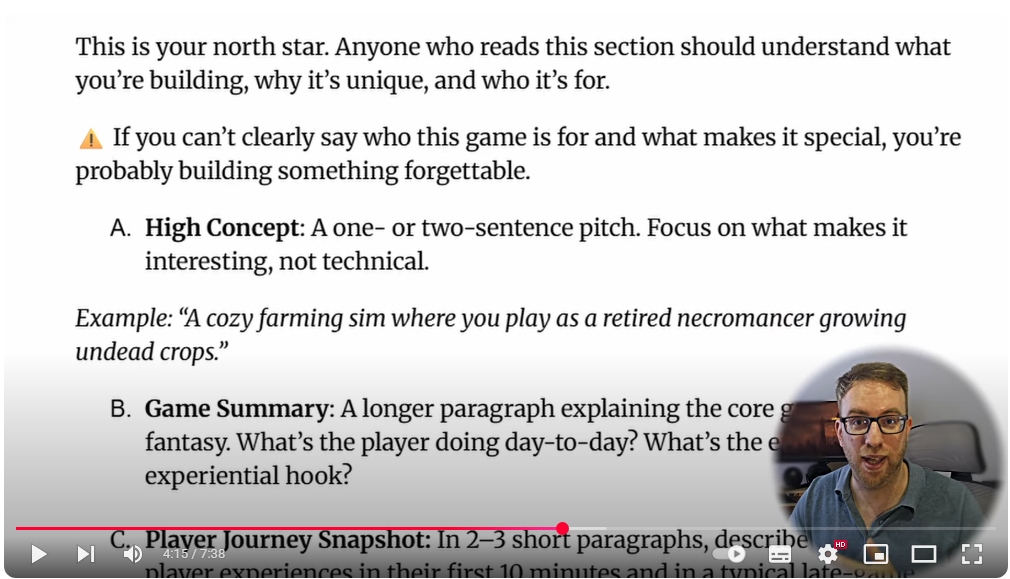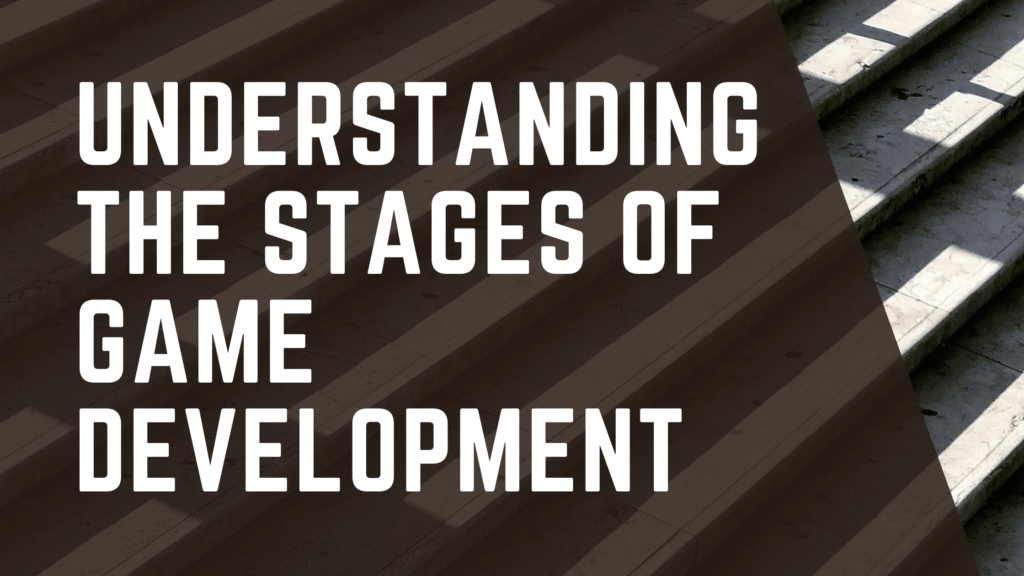The game design process is rarely a straight line – but knowing where you are in the process can mean the difference between finishing your game and chasing your tail for months. Whether you’re an indie dev, a small team, or a first-time producer, understanding the phases of video game development gives you the clarity to build smarter, avoid burnout, and actually ship your game.
This guide breaks down each phase of the process: what it’s for, what to focus on, and what to avoid. No fluff. Just a clear look at how games get made, one phase at a time.
Game Design Phase: Concepting
Define What You’re Making Before You Make Anything
This is the phase where your idea meets reality – and reality usually wins.
A strong concept can’t just be a ‘cool idea’. It has to be clear, and answer one very important question: is this idea strong enough to justify months (or years) of work?
If you can’t explain the game in a single sentence, how are you going to build it? Or pitch it? Or finish it without rewriting everything multiple times?
At this point you don’t need a full game design doc, but you should have:
- A solid one-liner (What is it? Why does it matter?)
- A few clear design pillars (What makes it stand out?)
- A well designed player fantasy (What is the player going to be getting out of this?)
This is a longwinded way of saying: create an elevator pitch for your game. If your concept crumbles under basic questions (like “what do you actually do?”), better to find out now, not halfway through production when you’re pulling out your hair. Don’t jump right into fancy features, systems and lore. You can’t balance a combat system that doesn’t exist.
This phase is where you zoom out and get brutally honest with yourself. Not just ‘is this cool?’, but ‘is it worth finishing?’
Game Design Phase: Pre-Production

Break The Idea Before It Breaks You
This is where you can stop daydreaming and start putting together the building blocks of your game.
At this point, you’re not here to polish. You’re here to crack the core gameplay loop, poke holes in your ideas and find things that are going to explode later – now, whilst it’s cheap and relatively painless.
So what does pre-production actually entail?
- Building a greybox version of your main mechanic.
- Validating the gameplay, not the graphics.
- Choosing your engine (Unity, Godot, Unreal).
- Setting up your pipelines, workflows, and any tools you actually need.
- Identifying technical or design risks early – and solving or cutting them.
This isn’t the sexy part – you don’t see people fawning over grey cubes. But if the game isn’t fun without shaders, it won’t be fun with them. Pre-production is where you build the pillars that keep your game from collapsing.
This is the stage where you build your game design document – so here’s a template if needed. This needs to be, at minimum, 5 pages long: and if you’re not prepared to fill them, you’re definitely not ready for this several-thousand-hour journey.
Game Design Phase: Production
Execute On The Stuff That Works
Here’s where your game can start to take shape. Validated your mechanics in pre-production? Good. Now it’s time to build out the systems, content, and UX – but only what’s been proven to work already. Production is all about making real progress.
Here’s what to focus on:
- Expanding the mechanics that survived testing
- Building content at scale – but within locked scope
- Solidifying your UX: menus, inputs, feedback, onboarding
- Tracking real progress: builds, tasks, checklists, tests
At this stage, your questions should begin shifting from ‘what if?’ to ‘how much?’ – and scope will become your mortal enemy. Take it from me: chasing vast new ideas mid-production is how 90% of indie projects end up in development hell. It’s normal to come up with new ideas in production, but it’s important to know when an idea isn’t worth pursuing. There are billions of games waiting to be made – and this idea can go in another one.
You have to lock in your scope and manage it like a hawk. Your job now is to finish features and systems, rather than devising big new ones (though some changes are to be expected!). This is where games actually get finished. Doesn’t that sound exciting?
Game Design Phase: Polish And Beta
Focus On How It Feels, Not Just How It Runs
You’ve built the systems, content, and structure. Now it’s time to make the game playable – not just functionally, but emotionally. How do you know when you’ve arrived at this stage? If all of the mechanics are in, you’re in beta. If you’re still adding features (these are mechanics, bare in mind, not content), then you’re still in alpha.
This is where players can actually get hands on with your game – and they will tear your game to pieces. Here, you discover all of the things that technically work, but don’t quite feel right. That’s not failure. That’s part of the game design process.
Here’s what to focus on:
- Difficulty ramp. Too easy, and it’s boring. Too hard, and it’s uninstall time.
- Flow. Make sure each part of the game transitions seamlessly into the next, balancing the player’s time for a great user experience.
- Player feedback. Gather it, but filter it through your actual design goals before actioning it. This stage is critical – without feedback, the game will only make sense in your head, if at all. Players are everything.
- Find the juice. Your game needs to feel good, and that’s finding the juice. Make every action feel great for the player.
- Onboarding. Can new players understand what to do?
It’s also important to note some things not to do:
- Don’t add new systems because someone on Discord had a “cool idea”.
- Don’t ignore repeated feedback because “they just didn’t get it”.
- Don’t focus on systems nobody sees while leaving core features clunky.
Polishing isn’t just adding juice, it’s removing friction. No amount of particle effects will save you if players are feeling frustrated and bored. You can’t polish chaos. By the end of this phase, your game should be a joy to play.
Game Design Phase: Release & Aftermath
Brace For Impact
You launched your game! First off, congratulations! Releasing anything is a big milestone. 99% of projects don’t make it this far, so it’s a testament to your dedication and perseverance, and a huge benchmark for any developer. But, the journey is far from over.
Here’s what you might expect:
- Spikes. Attention, downloads, praise, hate, bugs, memes and even more you didn’t (and couldn’t) prepare for.
- Panic. Bugs you never expected being uncovered, and builds breaking in unexpected ways.
- Silence. You might hear nothing. No players, no bug-fixes, and no attention. Sometimes, this is just the way things go. That’s why marketing is such a crucial step in indie game development.
Use the above to decide whether your game is a one-off, a platform, or a stepping stone. Met with silence, or less-than-stellar reviews with no clear path back? Probably a one-off. A dedicated community, eager for more content, DLC, and updates? It’s a platform. An audience pleased with the game as it is, but hungry to try more of your stuff? Definitely a stepping-stone to bigger, and better, things.
When your game releases, it’s no longer just yours. Players will misunderstand it, love it for the wrong reasons, and destroy – or make – your dreams. That’s beautiful.
Postmortem
Figure Out What The Hell Just Happened
You survived! Maybe you even thrived. It’s time to take a few steps back and look at your experience. What went well? What went wrong? What are we never going to do again?
You’ll forget a lot in a month. Document it while the scars are still fresh. This will help you to improve for your next project – especially if you’re planning on building a portfolio or studio. Most importantly, it’ll give you closure on this journey. A good postmortem makes the work feel worth it.
Game Dev Isn’t A Straight Line
If you’ve made it through all the stages – from concept to postmortem – congratulations. You’ve done something most people only talk about over drinks. Whether your game blew up, or quietly released into the void, you’ve done great.
Each phase of the game development process brings its own problems – but knowing what’s coming (and being a little less shocked when it arrives) is half the battle. And now, you’re better prepared for next time.


